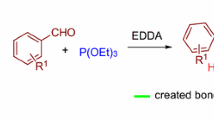Abstract
An expeditious neat procedure was developed for the synthesis of a series of new methyl phenyl heterocyclic phosphinates (3a–l) through Michaelis–Arbuzov reaction by the reaction of various heterocyclic halides (Cl or Br) (1a–l) with dimethyl phenylphosphonite (2) under N2 atmosphere using a heterogeneous catalyst, LaCl3.7H2O. The advantages of the developed procedure are good yields (80–89%) of the products, less reaction time (2–3 h), avoiding toxic catalysts and harmful solvents and easy work-up procedure. Further, antimicrobial activity of the synthesized compounds was evaluated at different concentrations 50, 100 and 150 μg/mL. Biological data revealed that compounds 3i, 3j and 3h, 3j exhibited potential antibacterial and antifungal activities, respectively, while the rest of the compounds showed moderate antimicrobial activity.

An expeditious neat procedure was developed for the synthesis of a series of new methyl phenyl heterocyclic phosphinates through Michaelis–Arbuzov reaction using a heterogeneous catalyst, LaCl3.7H2O.


Similar content being viewed by others
References
(a) Schug K A and Linder W 2005 Chem. Rev. 105 64; (b) Moonen K, Laureyn I and Stevens C V 2004 Chem. Rev. 104 6177; (c) Palacios F, Alonso C and Santos J M 2004 Curr. Org. Chem. 8 1481
(a) Thottathil J K, Przybyla C A and Moniot J L 1984 Tetrahedron Lett. 25 4737; (b) Allen M C, Fuhrer W, Tuck B, Wade R and Wood J M 1989 J. Med. Chem. 32 1652; (c) Malachowski W P and Coward J K 1994 J. Org. Chem. 59 7625
Wang L S, Kang H B, Wang S B, Liu Y and Wang R 2007 Fluid Phase. Equilibr. 258 99
Lligadas G, Ronda J C, Galia M and Cadiz V J 2006 Polym. Sci. Part A: Polym. Chem. 44 5630
Hwang M, Ha H Y and Kim D J 2008 Membr. Sci. 325 647
(a) Frank A W 1961 Chem. Rev. 61 389; (b) Shiau T P, Erlanson D A and Gordon E M 2006 Org. Lett. 8 5697
Alibert S, Santelli-Rouvier C, Castaing M, Berthelot M, Spengler G, Molnar J and Barbe J 2003 Eur. J. Med. Chem. 38 253
Herrin T R, Fairgrieve J S, Bower R R and Shipkowitz N L 1977 J. Med. Chem. 20 660
(a) Kuhkar V P and Hudson H R 2000 Synthesis of ∝-Aminoalkanephosponic and ∝-Aminophosphonic Acids (ed.) (Chichester, UK: John Wiley), pp. 537–555; (b) Kafarski P and Lejczak B 2001 Anticancer Agents Med. Chem. 1 301; (c) Berlicki L and Kafarski P 2005 Curr. Org. Chem. 9 1829; (d) Redmore D 1976 In Topics in phosphorus chemistry (eds) E J Griffith and M Grayson (New York: John Wiley) vol. 8, p. 515
(a) Fernandez M F, Vlaar C P, Fan H, Liu Y H, Fronczek F R and Hammer R P 1995 J. Org. Chem. 60 7390; (b) Shi E and Pei C 2004 Synthesis 18 2995
(a) Han L B and Zhao C Q 2005 J. Org. Chem. 70 10121; (b) Stockland R A, Taylor R I, Thomphson L E and Patel P B 2005 Org. Lett. 7 851; (c) Hirai Tand Han L B 2007 Org. Lett. 9 53
Francois R A, Agnes A, Stephanie B, Catherine C, Thierry C, Jocelyn J, Chiara M, Barbara P, Luana V, Michel L, Arlene R, Maria S, David S, Richard S and Cyril B D 2011 J. Med. Chem. 54 392
(a) Hartley F H (ed.) 1996 The chemistry of organophosphorus compounds (New York: Wiley); (b) Battacharya A K and Thyagarajan G 1981 Chem. Rev. 81 415
(a) Michaelis A and Kaehene R 1898 Cheme. Ber. 31 1408; (b) Arbuzov A E 1906 J. Russ. Phys. Chem. Soc. 38 687
Renard P Y, Varon P, Leclerc E, Valleix A and Mioskowski C 2003 Angew. Chem. 42 2389
Ogawa T, Usuki N and Ono N 1998 J. Chem. Soc. Perkin Trans. 1 2953
(a) Xu Y, Xia J and Guo H 1986 Synthesis 691; (b) Xu Y, Wei H, Zhang J and Huang G 1989 Tetrahedron Lett. 30 949
Arbuzov A E 1906 J. Russ. Phys. Chem. Soc. 38 687
Arbuzov B A 1964 Pure Appl. Chem. 9 307
Bhathcharya A R and Thyagarajan G 1981 Chem. Rev. 81 415
Narasimhulu M, Reddy T S, Mahesh K C, Reddy S M, Reddy A V and Venkateswarlu Y 2007 J. Mol. Catal. A. 264 288
Lu J, Bai Y, Wang Z, Yang B and Ma H 2000 Tetrahedron Lett. 41 9075
(a) Imamoto T 1994 In Lanthanides in organic synthesis (New York: Academic Press); (b) Kobayashi S 1994 Synlett 689; (c) Molander G A 1992 Chem. Rev. 92 29
Carran R, Maran A, Montero, Femadozlago L and Dominguez A 1987 Plants Med. Phyto. 21 195
Arima H, Ashida H and Danno G I 2002 Biosci. Biotechnol. Biochem. 66 1014
Miah M A T, Ahmed H U, Sharma N R, Ali A and Miah S A 1990 Bangladesh. J. Bot. 19 5
Quin L D and Verkade J G 1994 Phosphorus-31 NMR spectral properties compound characterization and structural analysis (New York: VCH Publishers) p. 450
Acknowledgments
The author, GM thanks the University Grants Commission (UGC), New Delhi, for the award of UGC-Junior Research Fellowship (JRF). SR, and DSR are thankful to the UGC, New Delhi, for awarding Junior Research Fellowship (JRF) under the scheme of Basic Scientific Research Programme (BSR).
Author information
Authors and Affiliations
Corresponding author
Additional information
Supplementary information
The electronic supplementary information consists of antibacterial data (table S1, figures S1 and S2) and antifungal data (table S2 and figure S3) can be seen in www.ias.ac.in/chemsci.
Electronic supplementary material
Below is the link to the electronic supplementary material.
Rights and permissions
About this article
Cite this article
GOLLA, M., SYED, R., KATLA, V.R. et al. LaCl3.7H2O: An efficient catalyst for the synthesis of phosphinates (Michaelis–Arbuzov reaction) under neat conditions and their potential antimicrobial activity. J Chem Sci 126, 117–125 (2014). https://doi.org/10.1007/s12039-013-0550-3
Received:
Revised:
Accepted:
Published:
Issue Date:
DOI: https://doi.org/10.1007/s12039-013-0550-3




